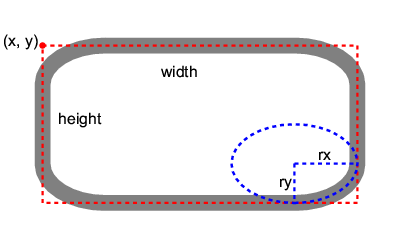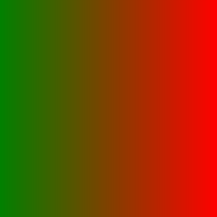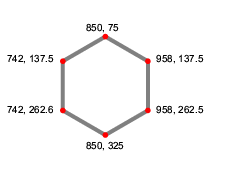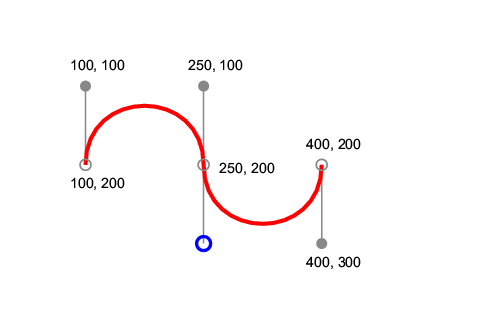Scalable Vector Graphics (SVG)
SVG can be included in any XML document simply by adding a
svg element.
Global definitions of graphical elements are supported, for example references to elements outside of the current SVG fragment, either in the same document or other documents. Defining these elements in a <defs> element helps understandability of the SVG element. You can use a <use> element to reference those elements later.
The display, float, and flow properties
and all margin, padding, border, and
background
properties can be applied to the top-level svg element but not to
child elements within it.
The following elements are supported
inside the svg element:
g |
for grouping related graphics elements |
rect |
for drawing rectangles |
circle |
for drawing circles |
ellipse |
for drawing ellipses |
line |
for drawing lines |
mask |
for masking another element |
polyline |
for drawing polylines |
polygon |
for drawing polygons |
path |
for drawing arbitrary paths |
text |
for drawing text |
tspan |
for adjusting text and font properties inside the text element
|
image |
for including bitmap image files |
a |
for creating hyperlinks |
defs |
for containing referenced elements |
use |
for using a referenced element |
Viewbox and viewport
The svg element should include view box and view port information
so that the SVG content can be correctly mapped to the containing box.
| Attributes | |
|---|---|
width |
the width of the viewport (100% of the container width, if omitted) |
height |
the height of the viewport (100% of the container width, if omitted) |
viewBox(x y width height) |
the x, y coordinate of the top left corner of the viewbox and the width and height of the viewbox |
XML
<svg width="3cm" height="2cm" viewBox="0 0 300 200">
<!-- the SVG content -->
</svg>
Rectangles
Rectangles are created using the rect element.
| Attributes | |
|---|---|
x, y
|
the x, y coordinates of the top left corner of the rectangle |
width |
the width of the rectangle |
height |
the height of the rectangle |
rx, ry
|
the radii for rounded corners |
XML
<svg viewBox="0 0 500 300"
width="10cm" height="6cm">
<g fill="none" stroke="gray" stroke-width="20">
<rect x="50" y="50" width="400" height="200"
rx="80" ry="50"/>
</g>
</svg>
Output

Circles
Circles are created using the circle element.
| Attributes | |
|---|---|
cx, cy
|
the centre of the circle |
r |
the radius of the circle |
XML
<svg viewBox="0 0 200 200"
width="5cm" height="5cm">
<g fill="none" stroke="gray" stroke-width="20">
<circle cx="100" cy="100" r="100"/>
</g>
</svg>
Output

Ellipses
Ellipses are created using the ellipse element.
| Attributes | |
|---|---|
cx, cy
|
the centre of the ellipse |
rx, ry
|
the radii of the ellipse |
XML
<svg viewBox="-10 0 220 200"
width="6cm" height="6cm">
<g fill="none" stroke="gray" stroke-width="20">
<ellipse cx="100" cy="100" rx="100" ry="60" />
</g>
</svg>
Output

Lines
Lines are created using the line element.
| Attributes | |
|---|---|
x1, y1
|
the start point of the line |
x2, y2
|
the end point of the line |
XML
<svg viewBox="0 0 100 50"
width="6cm" height="3cm">
<g stroke="gray" stroke-width="2">
<line x1="10" y1="25" x2="90" y2="25"/>
</g>
</svg>
Output

Masks
Masks are created using the mask element.
| Attributes | |
|---|---|
x |
the x-axis coordinate of one corner of the rectangle |
y |
the y-axis coordinate of one corner of the rectangle |
width |
the width of the rectangle |
height |
the height of the rectangle |
XML
<svg xmlns:xlink="http://www.w3.org/1999/xlink">
<defs>
<linearGradient id="Gradient">
<stop offset="0" stop-color="white" stop-opacity="0" />
<stop offset="1" stop-color="white" stop-opacity="1" />
</linearGradient>
<mask id="Mask" x="0" y="0" width="200" height="200">
<rect x="0" y="0" width="200" height="200" fill="url(#Gradient)" />
</mask>
</defs>
<rect x="0" y="0" width="200" height="200" fill="green" />
<rect x="0" y="0" width="200" height="200" fill="red" mask="url(#Mask)" />
</svg>
Output

Polylines
Polylines are created using the polyline element.
| Attributes | |
|---|---|
points |
list of points that defines the line. Points are separated by whitespace and each point is a pair of x, y coordinates separated by comma. |
XML
<svg viewBox="0 0 600 400"
width="6cm" height="4cm">
<g stroke="gray" stroke-width="10">
<polyline points="50,300 200,300 200,100
400,100 400,300 550,300" />
</g>
</svg>
Output

Polygons
Polygons are created using the polygon element.
| Attributes | |
|---|---|
points |
list of points that defines the line. Points are separated by whitespace and each point is a pair of x, y coordinates separated by comma. |
XML
<svg viewBox="600 0 600 400"
width="6cm" height="4cm">
<g fill="none" stroke="gray" stroke-width="10">
<polygon points="850,75 958,137.5 958,262.5
850,325 742,262.6 742,137.5" />
</g>
</svg>
Output

Paths
The path element is for drawing arbitrary paths.
The d attribute inside the element path takes
a list of path commands.
Parameters of a command can be separated either by whitespace or a comma.
| Command | Parameters | Meaning |
|---|---|---|
| M (absolute), m (relative) | (x y)+ | moves to the given (x, y) coordinates to start a new subpath |
| Z or z | none | closes the current subpath |
| L (absolute), l (relative) | (x y)+ | draws a line to the given (x, y) coordinates |
| H (absolute), h (relative) | x+ | draws a horizontal line to the given x coordinates |
| V (absolute), v (relative) | y+ | draws a vertical line to the given y coordinates |
| C (absolute), c (relative) | (x1 y1 x2 y2 x y)+ | draws a cubic Bézier curve to the given (x,y) coordinates, uses the given (x1,y1) coordinates as the first control point, the (x2,y2) coordinates as the second control point |
| S (absolute), s (relative) | (x2 y2 x y)+ | short hand of the C/c command: the reflection relative to the current point of the second control point of the previous command is used as the first control point. |
| Q (absolute), q (relative) | (x1 y1 x y)+ | draws a quadratic cubic Bézier curve to the given (x,y) coordinates, uses the given (x1,y1) coordinates as the control point. |
| T (absolute), t (relative) | (x y)+ | short hand of the Q/q command: the reflection relative to the current point of the control point of the previous command is used as the control point. |
| A (absolute), a (relative) | (rx ry x-axis-rotation large-arc-flag sweep-flag x y)+ | draws an elliptical arc to (x, y): the size and rotation of the ellipse are defined by two radii (rx, ry) and the x-axis-rotation; the center (cx, cy) of the ellipse is also determined by the large-arc-flag and sweep-flag constraint. |
XML
<svg viewBox="0 0 600 400"
width="12cm" height="8cm">
<g fill="none" stroke="red" stroke-width="10">
<path d="M100,200 C100,100 250,100
250,200 S400,300 400,200" />
</g>
</svg>
Output

Text
The text element is for writing arbitrary text.
The tspan element is supported inside the text
element, for adjusting text position and font properties.
| Attributes | |
|---|---|
x, y
|
the absolute position of the text |
dx, dy
|
the relative offset of the current text position (optional) |
XML
<svg viewBox="0 0 1000 300"
width="10cm" height="3cm">
<text x="200" y="150" fill="blue" font-size="70">
That
<tspan dx="2em" dy="-50" font-weight="bold" fill="red" >
is
</tspan>
<tspan dy="100">
a peach!
</tspan>
</text>
</svg>
Output

Images
The image element is for including external image files, either
bitmap images or other SVG images.
| Attributes | |
|---|---|
xlink:href |
the URL of the image to include |
x, y
|
the x, y coordinates of the top left corner of the image |
width |
the width of the image |
height |
the height of the image |
Note that the href element must be placed in the XLink namespace:
http://www.w3.org/1999/xlink in order to work.
XML
<svg xmlns:xlink="http://www.w3.org/1999/xlink"
...
<image x="100" y="100" width="50" height="50" xlink:href="myimage.jpg"/>
...
</svg>
Links
The a element is for creating hyperlinks.
| Attributes | |
|---|---|
xlink:href |
the URL of the link |
Note that the href element must be placed in the XLink namespace:
http://www.w3.org/1999/xlink in order to work.
XML
<svg xmlns:xlink="http://www.w3.org/1999/xlink"
...
<a xlink:href="http://www.example.com">
...
</a>
...
</svg>
Transformations
The transform attribute can be used on g,
path, and all of the basic shape elements.
It accepts any sequence of the following transformations separated by
whitespace.
- translate(tx ty)
- scale(sx [sy])
- rotate(angle)
- skewX(angle)
- skewY(angle)
- matrix(a b c d e f)
XML
<svg viewBox="-150 -200 1400 700" width="12cm" height="6cm">
<g fill="none" stroke-width="30">
<rect width="400" height="200" stroke="lightgray"/>
<rect width="400" height="200" stroke="darkgreen" transform="rotate(-30)"/>
<g transform="translate(700 100) rotate(-30)">
<rect width="400" height="200" stroke="blue"/>
</g>
</g>
</svg>
Output

Style Properties
The following style properties are supported on SVG elements:
baseline-shiftclip-pathclip-ruledominant-baselinefont-familyfont-sizefont-stylefont-weightfillfill-opacityfill-rulemarker-startmarker-midmarker-endstop-colorstop-opacitystrokestroke-dasharraystroke-dashoffsetstroke-linecapstroke-linejoinstroke-miterlimitstroke-opacitystroke-widthtext-anchor
Style properties can be applied using SVG presentation attributes:
<rect fill="yellow" stroke="blue" stroke-width="20"
width="200" height="100"/>
Or by using CSS properties inside the style attribute or element:
<rect style="fill:yellow; stroke:blue; stroke-width:20"
width="200" height="100"/>
